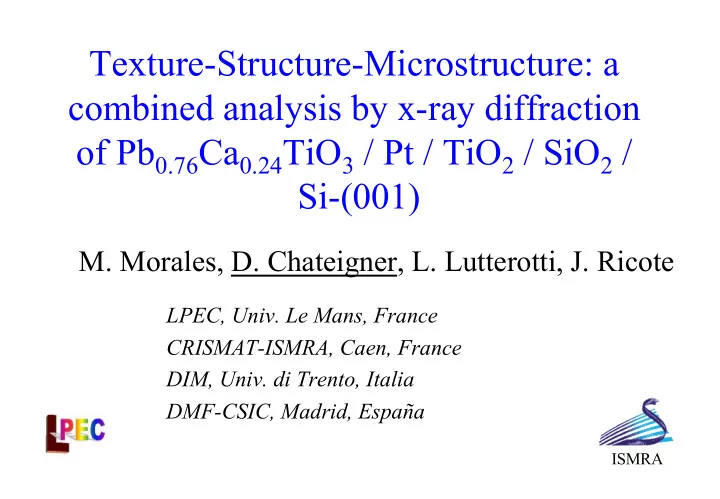

Texture-Structure-Microstructure: a combined analysis by x-ray diffraction of Pb 0.76 Ca 0.24 TiO 3 / Pt / TiO 2 / SiO 2 / Si-(001) M. Morales, D. Chateigner, L. Lutterotti, J. Ricote LPEC, Univ. Le Mans, France CRISMAT-ISMRA, Caen, France DIM, Univ. di Trento, Italia DMF-CSIC, Madrid, España ISMRA
Summary • Usual up-to-date approaches for polycrystals – Texture – Structure-Microstructure – Problems on ultrastructures • Combined approach – Experimental needs – Methodology-Algorithm – Ultrastructure implementation – Case study on Pb 0.76 Ca 0.24 TiO 3 • Future trends
Usual Texture Analysis X=010 Y {hkl} pole figure measurement + corrections: dV( ) 1 c χφ β = P( ) si n d d α χφ χ χ φ V 4 π Z=001 X Y=100 X=010 Y We want f(g) (ODF): with g = ( α , β , γ ) a c dV(g) 1 β α = f (g) dg Z=001 2 V 8 X Y=100 π γ b
We have to invert (Fundamental equation of Texture Analysis): � 1 ~ P ( y ) = f(g) d ∫ ϕ hkl 2 π � hkl // y < > ⎡ ⎤ ⎢ ⎥ n 0 f ( g ) f ( g ) WIMV refinement method: n 1 f ( g ) N + ⎢ ⎥ = Williams-Imhof-Matthies-Vinel � 1 ⎢ ⎥ ( ) ⎥ n P ( y ) ∏ I ⎢ hkl ⎣ ⎦ hkl
Usual Structure-Microstructure Analysis (Full pattern fitting, Rietveld Analysis) Si 3 N 4 matrix with SiC whiskers: I(2 ) = I ( 2 ) S ( 2 ) bkg(2 ) Random powder: ∑ θ θ θ + θ hkl, phases hkl, phases hkl, phases
L 2 I ( 2 ) S F m P θ = hkl hkl hkl 2 V c S: scale factor (phase abundance) F hkl : structure factor (includes Debye-Waller term) V c : unit-cell volume I S S ( 2 ) S ( 2 ) * S ( 2 ) θ = θ θ hkl hkl hkl S I : instrumental broadening S S : Sample aberrations crystallite sizes (iso. or anisotropic) rms microstrains ε
Problems on ultrastructures Ferroelectric film (PTC) Sum diagram Electrode (Pt) Antidiffusion barrier (TiO 2 ) Oxide (native, thermally grown) SC Substrate (Si) - Strong intra- and inter-phase overlaps 001/100 PTC 011/110 PTC + Si ( λ /2) 111 PTC + 111 Pt - Mixture of very strong and lower textures - texture effect not fully removable: structure Need something !! - structure unknown: texture
Combined approach Experimental needs Mapping Spectrometer space for correction of: - instrumental resolution - instrumental misalignments ω = 20° ω = 40° 60 ° 60 ° χ χ 0° 0°
Methodology-Algorithm Correction of intensities for texture: I hkl (2 θ , χ , ϕ ) = I hkl (2 θ ) P hkl ( χ , ϕ ) Rietveld WIMV Structure, Microstructure Texture Pole figure extraction (Le Bail method): P hkl ( χ , ϕ ) Rietveld and WIMV algorithm are alternatively used to correct for each others contributions: Marquardt non- linear least squares fit is used for the Rietveld.
Ultrastructure implementation Corrections are needed for volumic/absorption changes when the samples are rotated. With a CPS detector, these correction factors are: top film ( ( ) ) ( ( ) ) C g 1 exp Tg / cos / 1 exp 2 T / sin cos = − − µ χ − − µ ω χ 1 2 χ ( ( ) ) ( ( ) ) cov. layer top film ' ' ' ' C C exp g T / cos / exp 2 T / sin cos ∑ ∑ = − µ χ − µ ω χ 2 i i i i χ χ Gives access to individual Thicknesses in the refinement
Case study on Pb 0.76 Ca 0.24 TiO 3 PTC a = 3.945(1) Å c = 4.080(1) Å T = 4080(10) Å a = 3.955(1) Å t iso = 390(7) Å T' = 462(4) Å Pt ε = 0.0067(1) t' iso = 458(3) Å ε ' = 0.0032(1)
WIMV vs Entropy modified WIMV approach Better refinement with E- WIMV: WIMV - lower reliability factors (structure and texture) - better high density level reproduction E-WIMV Texture Pt PTC Pt PTC Texture Texture RP 0 RP 0 Rw R Bragg Index Index (m.r.d. 2 ) (m.r.d. 2 ) (%) (%) (%) (%) WIMV 48.1 1.3 18.4 11.4 12.4 7.7 EWIMV 40.8 2 13.7 11.2 7 4.7
Future trends - Combining with reflectivity measurements: independently measured and refined thicknesses, electron densities and roughnesses - Adding residual stress determinations - Multiple Analysis Using Diffraction, a web-based tutorial for the combined approach: search MAUD (Luca Lutterotti) - Quantitative Texture Analysis Internet Course: http:// lpec.univ-lemans.fr/qta (Daniel Chateigner) Acknowledgements This work is funded by EU project ESQUI (http://lpec.univ- lemans.fr/esqui : an x-ray Expert System for microelectronic film QUality Improvement, G6RD-CT99-00169), under the RTD program.
Quantitative Texture Analysis Internet Course http://lpec.univ-lemans.fr/qta
Recommend
More recommend